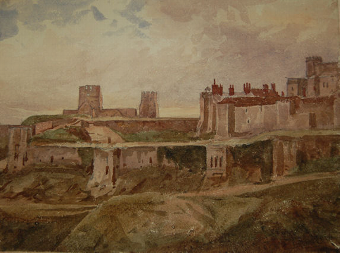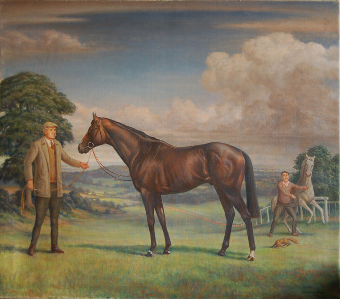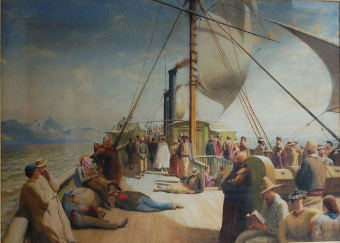an interior view of an arcade at the alhambra, granada spain
- View other items in:
- antiques interior design modern and vintage
- other interior design
artware ltd
Enquire about this antique
Artware Ltd has 565 antiques for sale.
click here to see them all
Completed towards the end of Muslim rule of Spain by Yusuf I (1333?1353) and Muhammed V, Sultan of Granada (1353?1391), the Alhambra is a reflection of the culture of the last centuries of the Moorish rule of Al Andalus, reduced to the Nasrid Emirate of Granada. It is a place where artists and intellectuals had taken refuge as the Reconquista by Spanish Christians won victories over Al Andalus. The Alhambra integrates natural site qualities with constructed structures and gardens, and is a testament to Moorish culture in Spain and the skills of Muslim, Jewish, and Christian artisans, craftsmen, and builders of their era.The literal translation of Alhambra, "red fortress", reflects the colour of the red clay of the surroundings of which the fort is made. The buildings of the Alhambra were originally whitewashed; however, the buildings now seen today are reddish.The first reference to the Qal?at al Hambra was during the battles between the Arabs and the Muladies during the rule of the ?Abdullah ibn Muhammad (r. 888-912). In one particularly fierce and bloody skirmish, the Muladies soundly defeated the Arabs, who were then forced to take shelter in a primitive red castle located in the province of Elvira, presently located in Granada. According to surviving documents from the era, the red castle was quite small, and its walls were not capable of deterring an army intent on conquering. The castle was then largely ignored until the eleventh century, when its ruins were renovated and rebuilt by Samuel ibn Naghrela, vizier to the King Badis of the Zirid Dynasty of Al Andalus, in an attempt to preserve the small Jewish settlement also located on the Sabikah hill. However, evidence from Arab texts indicates that the fortress was easily penetrated and that the actual Alhambra that survives today was built during the Nasrid Dynasty.
Emblem of the Catholic Monarchs engraved after the conquest.Ibn Nasr, the founder of the Nasrid Dynasty, was forced to flee to Ja?n in order to avoid persecution by King Ferdinand III of Castile and the Reconquista supporters working to end Spain''s Moorish rule. After retreating to Granada, Ibn-Nasr took up residence at the Palace of Badis in the Alhambra. A few months later, he embarked on the construction of a new Alhambra fit for the residence of a king. According to an Arab manuscript since published as the An?nimo de Granada y Copenhague, This year, 1238 Abdallah ibn al-Ahmar climbed to the place called "the Alhambra" inspected it, laid out the foundations of a castle and left someone in charge of its construction? The design included plans for six palaces, five of which were grouped in the northeast quadrant forming a royal quarter, two circuit towers, and numerous bathhouses. During the reign of the Nasrid Dynasty, the Alhambra was transformed into a palatine city complete with an irrigation system composed of acequias for the gardens of the Generalife located outside the fortress. Previously, the old Alhambra structure had been dependent upon rainwater collected from a cistern and from what could be brought up from the Albaic?n. The creation of the Sultan''s Canal solidified the identity of the Alhambra as a palace-city rather than a defensive and ascetic structure. The Muslim ruler Muhammad XII of Granada surrendered the Emirate of Granada in 1492 without the Alhambra itself being attacked when the forces of Los Reyes Cat?licos, King Ferdinand II of Aragon and Queen Isabella I of Castile, took the surrounding territory with an overwhelming force of numbers.
The decorations within the palaces typified the remains of Moorish dominion within Spain and ushered in the last great period of Andalusian art in Granada. With little influence from the Islamic mainland[citation needed], artists endlessly reproduced the same forms and trends, creating a new style that developed over the course of the Nasrid Dynasty. The Nasrids used freely all the display of stylistical resorts that had been created and developed during eight centuries of Muslim rule in the Peninsula as the Calliphal horse-shoe arch, the Almohad sebka or the Almoravid palm, and unused combinations of them, beside novelties as the stilted arches and the capitals of muqarnas, among others. The isolation with the rest of the Islam, and the commercial and political relationship with the Christian kingdoms also influenced in the space concepts. El mirador de Lindaraja.Columns, muqarnas and stalactite-like ceiling decorations, appear in several chambers, and the interiors of numerous palaces are decorated with arabesques and calligraphy. The arabesques of the interior are ascribed, among other kings, to Yusuf I, Mohammed V, and Ismail I. After the Christian conquest of the city in 1492, the conquerors began to alter the Alhambra. The open work was filled up with whitewash, the painting and gilding effaced, and the furniture soiled[citation needed], torn, or removed. Charles V (1516?1556) rebuilt portions in the Renaissance style of the period and destroyed the greater part of the winter palace to make room for a Renaissance-style structure which was never completed. Philip V (1700?1746) Italianised the rooms and completed his palace in the middle of what had been the Moorish building; he had partitions constructed which blocked up whole apartments. Over subsequent centuries the Moorish art was further damaged, and, in 1812, some of the towers were destroyed by the French under Count Sebastiani. In 1821, an earthquake caused further damage. The restoration work undertaken in 1828 by the architect Jos? Contreras was endowed in 1830 by Ferdinand VII. After the death of Contreras in 1847, it was continued with fair success by his son Rafael (d. 1890) and his grandson. Designed to reflect the very beauty of Paradise itself, the Alhambra is made up of gardens, fountains, streams, a palace, and a mosque, all within an imposing fortress wall, flanked by 13 massive towers.
Antiques.co.uk Ref: 7FYDG924
- Materials:
- Pencil and Watercolour
- Width (cm):
- 39.00 x 28.00 cm 15.53 x 11.01 ins
Artware Ltd
Artware Fine Art specialises in fine antique, decorative and historical portraits and topographical pictures . We cover a period from the 17th and 18th centuries through to the 19th & 20th Centuries. We have over 150 portraits in stock, which can be viewed on our web site, each historical portrait has well researched biographical information both on the sitter and the artist.
Contact details
18 La gare
51 Surrey row
London
Greater London
SE1 0BZ
UNITED KINGDOM
T: 0207 921 97904
E: greg@artwarefineart.com
W: www.artwarefineart.com














